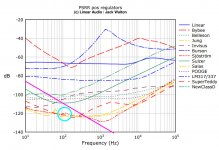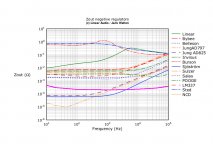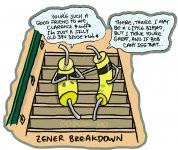I'm going with an E-562 (mostly because it comes a diode shape and the widely-spaced pads are easier to lay out).
From 20Hz we're at 90dB attenuation, 3mOhms output impedance and 1uV residual ripple.
It still makes 70dB and 10mOhms (the original target specs) at 2Hz.

From 20Hz we're at 90dB attenuation, 3mOhms output impedance and 1uV residual ripple.
It still makes 70dB and 10mOhms (the original target specs) at 2Hz.
Attachments
Jeff ,
The J170(B ) about 8mA IDSS could be used. I would add a resistor between gate and source to adjust the current to about 5 mA as pico suggests for lowest noise.
Don't, forget that the 2SK170 is a 25V part so a resistor in series with it is in order.
Question, What can you attach to the junction of the resistor and current diode to further reduce noise ? 😉
Jam
The J170(B ) about 8mA IDSS could be used. I would add a resistor between gate and source to adjust the current to about 5 mA as pico suggests for lowest noise.
Don't, forget that the 2SK170 is a 25V part so a resistor in series with it is in order.
Question, What can you attach to the junction of the resistor and current diode to further reduce noise ? 😉
Jam
You can reduce the amount of non-DC pollution at the base of Q23 by another factor of ~30X (29 dB), if you add one more resistor. 2.2K 1/4W metal film very inexpensive.
BTW that E-562 current regulator diode looks expensive if you buy it in thru hole packaging.
_
BTW that E-562 current regulator diode looks expensive if you buy it in thru hole packaging.
_
Last edited:
...no, no not the dreaded TL431, 😛
Pico I will send you a PM about the pots.
Jam
That was just me trying to be non-descriminatory.
Poor TL431.
Hahahahahaha
Indeed, but the noise there is no longer the limiting factor -- so it doesn't help at the output.You can reduce the amount of non-DC pollution at the base of Q23 by another factor of ~30X (29 dB), if you add one more resistor. 2.2K 1/4W metal film very inexpensive.
My aversion to parts count is more about minimalism than economics. And it's still half the price of a 1N5314. 😉BTW that E-562 current regulator diode looks expensive if you buy it in thru hole packaging.
It looks like NJSemi is still making the J511 (as is Linear Systems). LS's price is even worse than the E-562, and I can't find a price for the NJSemi part.
Jeff,
The E-562 is what I sometimes use as well as a 2SK170 both of wich perform the same. Look at the current source in the HPA-1 regulator you drew up....inexpensive and easily repeatable. Just saying..........😉
I generally always use base stoppers...just in case.
Jam
The E-562 is what I sometimes use as well as a 2SK170 both of wich perform the same. Look at the current source in the HPA-1 regulator you drew up....inexpensive and easily repeatable. Just saying..........😉
I generally always use base stoppers...just in case.
Jam
Last edited:
+1 for base stoppers, even if they are just 10 Ohm place holders.
Or even if they are just wire link holders.
.... Look at the current source in the HPA-1 regulator you drew up....inexpensive and easily repeatable.
Ahh! That's the other idea I had when drifting off to sleep last night! I couldn't remember what it was when I woke up.
(The third idea was to copy the ripple down to the tail of the LTP so that the LTP transistors saw the ripple on both sides. I remember this from Broskie's Aikido, but I couldn't make it work in silicon.)
You can do a lot better than using a 27V Zener.
If you are gonna spend money on a jfet ccs etc, it would make sense to use something better than a 27V Zener.
If you are gonna spend money on a jfet ccs etc, it would make sense to use something better than a 27V Zener.
... You can reduce the amount of non-DC pollution at the base of Q23 by another factor of ~30X (29 dB) ...
Indeed, but the noise there is no longer the limiting factor -- so it doesn't help at the output.
Then you need more gain. That is the reason why the Jung and the Sjostrom regulators got excellent ripple rejection at 2 x fmains: they have super high gain. (I'm not familiar with the others inside the blue circle)
_
Attachments
...My aversion to parts count is more about minimalism than economics...
? Then wouldn't something like an LM3886 make more sense, just pick a nice Vref and set the gain, job done! but where's the fun in that 🙂
Yes....? Then wouldn't something like an LM3886 make more sense, just pick a nice Vref and set the gain, job done!
Exactly. 😀... but where's the fun in that 🙂
I saw those graphs before. It's from an article on linear audio website. They are measured results. The article is on this website. The Superregs | Linear Audio NL
I had a pretty expensive yamaha receiver once, all it used for its 12v regulator was a jfet current source with a zener diode and a Darlington transistor, and a few caps. It used a 2sk208 and a 2sd2014.
Jeff,
Operating the Zener too close to knee will be noisy. Optimum current for most zeners is 4 to 5 mils.
You may want try two 13v zeners in series.
I would be interesting to replace the zener with Vbe multiplier.
Jam
Operating the Zener too close to knee will be noisy. Optimum current for most zeners is 4 to 5 mils.
You may want try two 13v zeners in series.
I would be interesting to replace the zener with Vbe multiplier.
Jam
Attachments
Last edited:
- Home
- Amplifiers
- Pass Labs
- JamJar: an HPA-1-inspired power amp




